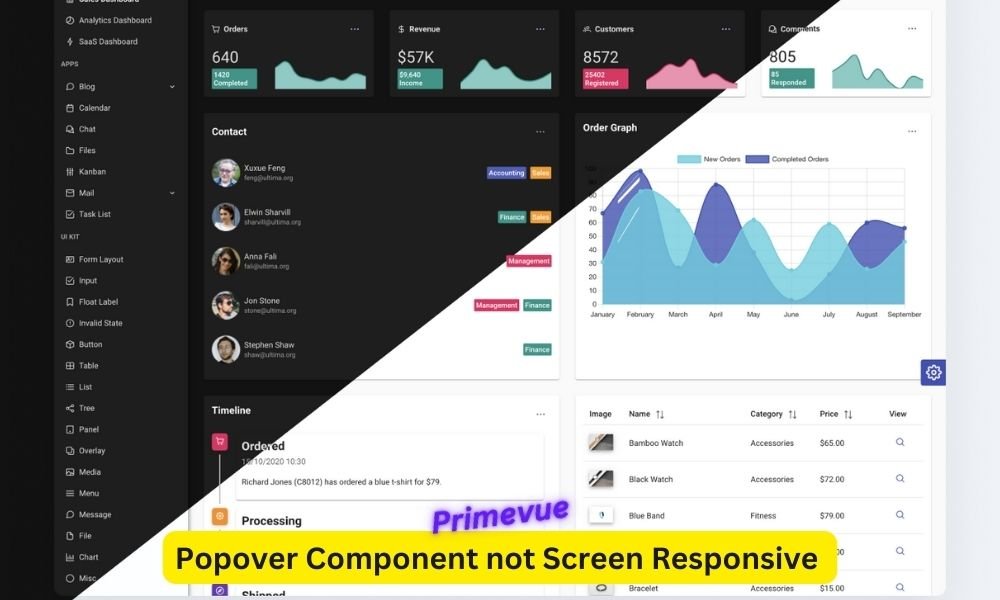Creating fluid interactions in web based applications is a core competency for programmers and UI/UX designers. One component that usually demands careful detail is the popover component, more so, in making sure it is responsive on the screen. In this blog post, we will discuss ways in which one can solve the issues concerning the popover component not being screen responsive in PrimeVue, helping you improve the user interface of your web application.
The Versatility of PrimeVue Popovers
One of the interesting components offered by PrimeVue UI components is the popover due to its interactivity. It is meant to hold almost any content; text content, even up to HTML structures making it popular as tooltips, advisory texts, user menus, etc. But what happens in these scenarios when responsiveness is not met?
Importance of Responsive Design
Given the variety of devices in use today, it is critical to implement responsiveness in the UI components such as popovers. A popover that does not resize could negatively affect the use of the application, leading to a negative experience and pushing the user away. Therefore, it is relevant to analyse and resolve popover components, not screen responsive issues in PrimeVue.
Understanding Popover Functionality
Key Features of PrimeVue Popovers
Customization is the forte of PrimeVue popovers as positioning and events can be adjusted as per the requirements. Such freethinking helps the developer to modify the interactions as per the needs of the users. Though being able to contain a multitude of content, including text and even interactivity, popovers serve a purpose by making the users active.
Default Responsive Behavior
The problem arises when the popovers of the PrimeVue components cannot be viewed properly, and this mostly happens with smaller devices despite the fact that these popovers are responsive. One can argue that the default behaviour will not always suit certain application requirements and therefore, custom made approaches may be necessary.
Common Use Cases for Popovers
Popovers are commonly implemented to display some additional information without creating mess up on the UI. They are important in displaying tooltips, user menus and also action calls. Nonetheless, these advantages may be limited if the popover component is not responsive in nature.
Identifying Responsiveness Issues
Touch Interaction Challenges
It is expected that popovers will not only be intuitive when used in conjunction with touch devices, but that they will also face difficulties such as getting accidentally dismissed or being hard to tap on. Given that most users engage in a mobile environment, this tends to lead to extreme irritation in the users.
Content Overflow Problems
Boundaries of a text box which extrudes beyond edges or outlines which appear present but are left untouched by the image layers are signs of common problems in non-responsive pop overs. Such issues are not only cosmetic but also impact how a user is able to interact with the content. Hence, they need to be resolved immediately.
Layout Inconsistencies
When users do not resize popovers to screen size other than the intended one, it may end up in an uncentered content or a broken grid layout for the design. These caused inconsistencies can especially interfere with the structure as a whole and make the user ‘experience’ poor.
Screen Size Breakpoints
Popovers while navigating through the screen size transitions may face difficulties and may not always be rendered appropriately. Therefore, the users are left with overlapping UI components and the app interface is rendered messily. Thus there is a definite need to address the screen responsiveness issue.
Optimizing Popover Content
Using Scalable Vector Graphics (SVGs)
Responsive design which uses SVG’s is effective as its quality is retained on all devices. For instance, in the case of using a popover, unlike raster images, SVG images ensure that your popover will always remain clear, sharp and accurately proportioned to any screen size used.
Optimizing Text Readability
Engagement would generally depend on readability. Texts should also have cross containment with relative units and use of fluid typography, breaking the problems associated with non-responsive design whereby texts are difficult to read on some of the devices.
Implementing Collapsible Sections
Collapsible sections help in organising information which will take up space in popovers. This alternative doesn’t only improve organisation, but also maintains the neatness of popovers.
Prioritizing Essential Information
Popovers can be short and uncluttered but are still informative as attention is directed to key points and transparent rendering is employed. This solution gives users the chance to see more information if they want to without inundating them at the beginning.
Quick Fixes for Responsive Popovers
Using CSS Media Queries
Through the use of media queries, styling for each of the devices can be changed to fit appropriately. CSS styling can be extended to ensure that popover controls appear as intended, irrespective of the particular device in view.
Leveraging PrimeVue Configuration Options
Apart from this in PrimeVue features like autoPositioning and custom breakpoints are also available improving how the components are used citing flexibility. These are critical in making certain your popovers stand a chance in a series of other popovers of different screen size.
Implementing a Mobile-First Approach
This ensures that your popover components are response ready for smaller screens before that are sized up. This is most of the time leads to much better designs, cleaner and far more focused than the rest.
Testing and Debugging Responsive Behavior
Automated Responsive Testing Tools
With tools such as Responsinator or LambdaTest, such solutions, it’s easier to determine whether any or all responsiveness issues can be fixed. Such platforms provide feedback on the behaviour of your popovers in different environments.
Browser Developer Tools
Built-in browser tools allow real time testing, as you can test and see what impact the changes have made on the various screen sizes. This practical action is very useful for enhancing responsiveness.
Device-Specific Testing
System by system testing gives assurance that the designs created will be effective. This phase is important in testing whether your popovers work on all the platforms they are meant for.
Navigating the Path to Responsive Popovers
Recap of Key Strategies
Responsiveness of your PrimeVue popovers calls for combining content triage, smart designer choices, and a lot of testing to achieve. This will enhance user experience to a very great degree.
Encouragement to Apply Solutions
Addressing popover components, not screen responsive issues is not only helpful in maximising effectiveness but is also a good way to show that your company cares about its customers. Developers should be convinced of the necessity to do so in order to gain the market’s advantage.
By addressing issues of usability in relation to web applications prospectively, one is assured of optimal user experience in all devices. Look into other securities as well and enhance the use of your popover for better user experiences.
Frequently Asked Questions
What are the common reasons popovers might not be responsive on smaller screens?
Some of the common reasons are not using SVGs, not using CSS media queries, not designing the UI for touch screens and ignoring responsive typography. These are within reach and actually can be solved.
Can PrimeVue popovers be customized for better responsiveness?
Yes, PrimeVue allows you to make several configurations such as autoPositioning plus adding breakpoints which are very helpful if responsiveness is to be maximised. Through these features, further enhancement of the popover’s responsiveness according to various screen sizes can be achieved.
How can I test if my popovers are responsive effectively?
It is possible to use some automated testing like Responsinator and LambdaTest to do that. On the other hand, the use of browser developers tools provides the possibility of testing, making and checking changes immediately whilst the final testing using actual devices always guarantees effective results.
What is a mobile-first approach, and why is it important?
A mobile first approach is designing your components with mobile devices in mind first before multipurpose screens. This is mostly advantageous as it makes one’s designs compactable to the very small screen hence improving the end products as they will be focused.
How do collapsible sections benefit popover content?
In order to avoid overstuffing the popover with content, collapsible sections provide a way of partitioning related information together. This is useful in keeping the content in order and consequently making sure that the popover is quite clear and uncluttered hence enhancing user experience.




